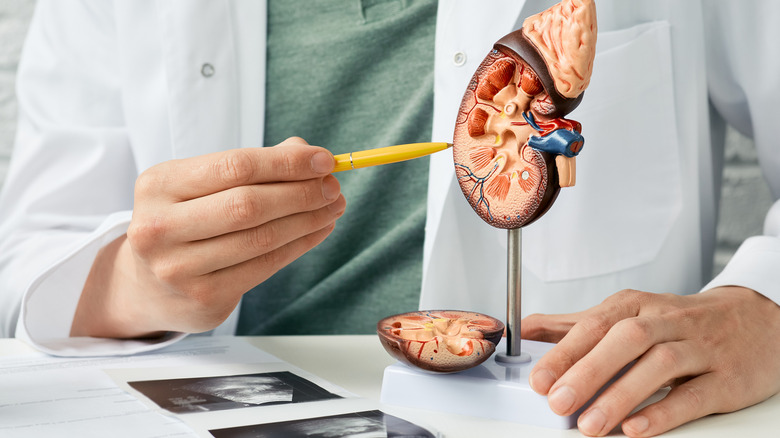What's The Difference Between Gallstones And Kidney Stones
According to WebMD, two common types of stones include gallstones and kidney stones. Some people may be more prone to developing either one of these conditions due to several risk factors. For example, the risk factors for kidney stones include dehydration, family history, and obesity. An increase in your BMI (body mass index) correlates with a higher risk of developing kidney stones, per the Mayo Clinic. According to Johns Hopkins Medicine, the risk factors for gallstones include gender (women are more likely to develop gallstones than men), age (the risk of gallstones increases with age), obesity, excess estrogen, and rapid weight loss. Losing weight quickly, particularly through crash diets or weight-loss surgery, increases the risk of gallstones.
Although gallstones and kidney stones are both types of stones, they occur in different organs and have different causes. Treatment for each condition will depend on the location of the stone, and the severity of the symptoms. In some severe cases, surgical or medical intervention may be needed (via Healthline). It is important to consult a healthcare professional for proper diagnosis and treatment.
How do gallstones and kidney stones differ?
Gallstones are formed in the gallbladder, a small organ located under the liver. They are typically made of cholesterol but can also be made of other substances, such as bilirubin, according to Johns Hopkins Medicine. Gallstones can vary in size — some appear the size of a sand grain while others are as big as a golf ball, per the Mayo Clinic. They can cause symptoms such as pain in the upper right abdomen, nausea, vomiting, and fever. In some cases, they may cause no symptoms at all.
Kidney stones, on the other hand, form in the kidneys, which are located mid-back just under the ribcage on each side of the body (via American Kidney Fund). There are various types of kidney stones — most are typically made of calcium, but some are also made of other substances such as uric acid or cystine, explains the Mayo Clinic. Kidney stones can also vary in size — from as small as a sand grain to as big as a golf ball, per the Cleveland Clinic – with the majority being about the size of a chickpea. They can cause symptoms such as severe pain in the lower back or side, blood in the urine, and nausea or vomiting.
How are gallstones and kidney stones treated?
Treatment for gallstones can vary depending on the size and location of the stones, as well as the severity of the symptoms. In some cases, stones don't interfere with the functioning of the gallbladder and require no treatment (via Johns Hopkins Medicine). In other cases, stones may need to be removed surgically. According to the Mayo Clinic, the most common surgical procedure to remove gallstones is called a cholecystectomy, which involves removing the gallbladder. Medications may also be used to help break up the stones or to prevent new stones from forming.
Treatment for kidney stones can also vary depending on the size of the stones. Stones may need to be removed surgically, either by retrieving them in a special "basket" or breaking them apart with a laser or shockwave lithotripsy so they can exit the body naturally. When stones can't be treated by other methods, a procedure called percutaneous nephrolithotomy is performed by inserting a tube directly into the kidney so that stones can be broken down by an ultrasound probe and suctioned out, says the Cleveland Clinic.
Drinking plenty of water might help prevent a build-up of stones. Medications may also be used to help break up the stones or to prevent new stones from forming. In some cases, medications called "alpha blockers" may be prescribed to help relax the muscles in the urinary tract and allow the stone to pass more easily (via the Mayo Clinic).



